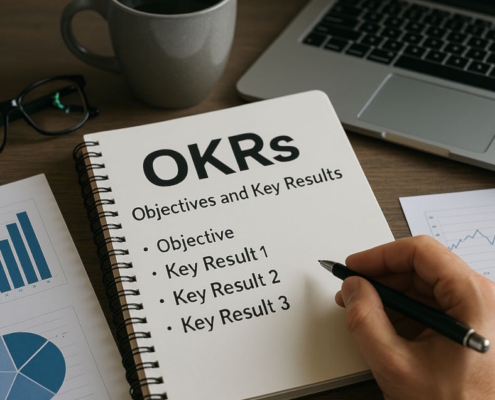What is the definition of retained earnings?
Once dividends have been paid out, a company’s net profits or earnings are known as retained earnings. An essential idea in accounting, “retained” conveys the idea that the corporation kept those earnings rather than paying dividends to shareholders.
A company’s retained earnings go down when it makes a loss or pays dividends, and they go up when it makes a profit.
How to Determine Retained Earnings and Use the Formula
Retained earnings = beginning period RE + net income/loss – cash dividends – stock dividends
How Can You Interpret Retained Earnings?
In accounting, retained earnings are a company’s net profit after deducting dividends paid out in the past.
In order to better grasp what retained earnings can reveal, the following possibilities cover all of the potential uses of an organization’s excess funds. In the first case, for example, the company’s earned money would permanently disappear from the accounts and books due to the irreversible nature of dividend payments.
The remaining choices all involve reinvesting or otherwise using the profits for internal company purposes; this is known as retained earnings.
- The owners (shareholders) of the company might receive dividends, which are a distribution of income, in whole or in part.
- The money may be used to grow the company by doing things like recruiting additional salespeople or boosting the production volume of current items.
- A company that makes refrigerators could use the money to build air conditioners, while a chocolate cake maker could use it to make cakes with fruit or nut fillings.
- Mergers, acquisitions, or partnerships that enhance company prospects are all fair game for the funds.
- Buying back shares is another possible purpose.
- The company might utilize the earnings to pay off any debts or loans that are now due.
Company management has the option to reinvest retained earnings, also known as earnings surplus, back into the firm. It is sometimes referred to as the retention ratio, and it is equal to one minus the dividend payout ratio when presented as a percentage of total profits.
Even if the last debt repayment option also causes money to leave the company, it does affect the books (for instance, by preventing interest payments in the future, which makes it eligible for retained earnings).
With a profit, the firm owner or managers have a lot of leeway to spend the extra cash. While most companies distribute their profits to their shareholders, some choose to reinvest them for future growth. Retained earnings are the funds that are not distributed to shareholders.
Retained Earnings and Management
Typically, it is up to the company’s management to decide whether to keep the profits or distribute them to the shareholders.
The shareholders, however, as the legal owners of the business, have the power to overturn it by a simple majority vote.
There could be a number of reasons why shareholders and management might prefer that the business keep its profits. Now that they have a better grasp of the industry and the inner workings of the firm, upper management may be planning a high-growth endeavor that they believe has the potential to bring in significant profits down the road.
Shareholders may benefit more from these endeavors than from dividend payments in the long term. It is possible that executives and shareholders might rather forego dividend payments in favor of paying down high-interest debt.
Conversely, when a business has a surplus of income, some of its long-time shareholders may anticipate receiving dividend payments on a regular basis as compensation for their investment. Investors seeking quick profits could also choose dividend payments that provide immediate benefits.
The management team usually strikes a middle ground. It entails maintaining a significant share of the earnings while giving out a small quantity of dividends, resulting in a situation in which both parties benefit.
How Are Dividends and Retained Earnings Different?
Shares of stock or cash are two common ways that dividends are paid out.
Dividends in any form cut into retained earnings. Financial records reflect dividend payments as net decreases because they cause a cash outflow. When a business pays out dividends in the form of cash, it effectively gives up control of its liquid assets, which lowers their worth on the balance sheet and has an effect on retained earnings.
In contrast, while stock dividends do not result in a direct outlay of funds, they do convert a portion of retained earnings into common stock. For example, if a corporation were to pay one share in the form of a dividend for every share that investors held, the price per share would decrease by fifty percent due to the fact that the number of shares would virtually double. Adjusting the market price per share based on the percentage of the stock dividend is necessary since the announcement of a stock dividend alone has not generated any tangible value for the firm.
While a rise in the volume of shares might not affect the balance sheet of the organization due to automated adjustments to the market price, it does lower the per-share worth, which is represented in capital accounts and affects the RE.
In order to fund growth-oriented operations including R&D, marketing, capital needs, capital expenses, and purchases, a corporation focused on growth may choose to keep earnings rather than issue dividends, or offer minimal dividends. The retained earnings of these types of businesses tend to be very substantial.
Companies that are nearing maturity sometimes have a surplus of cash on hand and may prefer to distribute it to shareholders rather than invest it in high-return ventures. This type of company often has a low RE.
How Are Revenue and Retained Earnings Different?
When it comes to assessing the state of a company’s finances, retained profits and revenue are both significant factors; nevertheless, they both shed light on something different about the overall financial picture. If you want to know how well a business is doing financially, you should look at its revenue, which is the first figure on the income statement.
A company’s revenue is the amount of money it makes in a certain time, before deducting operational expenditures and overhead expenses. Revenue is sometimes referred to as gross sales in some sectors due to the fact that the gross amount is determined prior to any deductions.
The amount of a company’s total profit that is kept or maintained for the purpose of being used in the future is referred to as the company’s retained earnings. One possible application for retained earnings is to pay shareholders dividends or to finance an expansion. It is important to note that retained earnings are connected to net income, versus gross income, since they represent the amount of net income that a corporation has preserved over the course of time.
Do Retained Earnings Have Any Limits?
When it comes to providing relevant insight, the absolute amount of retained earnings for a specific year or quarter might not be the most useful information for an analyst. Looking at it over a long period (say, five years) will simply show you the general trend of the amount of money that a firm is adding to its retained earnings.
Those who are interested in investing would like to have a great deal more information, including the returns that the retained profits have made and whether or not they were preferable to any other investments. Furthermore, investors may be more interested in bigger dividend payments than in substantial yearly improvements to retained earnings.
What Does Retained Earnings to Market Value Mean?
An important metric to consider is the ratio of retained earnings to market value, which provides insight into the efficiency with which an organization uses retained funds. It compares the growth in the stock price to the net earnings kept by the business and is computed over a long period of time (sometimes a few years).
Take Apple Inc. (AAPL) as an example; its stock price increased from about $28 to about $112 per share from September 2016 to September 2020.
The firm paid out a total of $3.38 per share in dividends over the same time, while EPS was $13.61.
Total earnings per share (EPS) and dividends paid out by Apple for the specified time period are as follows, as shown in the company’s 2020 10-K filing.
The corporation’s retained net earnings may be calculated as follows: $13.61 – $3.38 = $10.23. This is the difference between total EPS and total dividend. In other words, the firm kept $10.23 in earnings per share for the time.
In that time frame, a share of the stock increased in value by $84. The corporation was able to generate around $8.21 worth of market value for every dollar of retained earnings when they divided the price increase per share by the net profits retained per share, which came to 8.21.
The amount of value that was produced would have been lower if the corporation had not kept this money but rather taken out a loan that included interest instead. This is because the interest payment would have been a negative factor. Companies that are profitable are able to create value efficiently because they are able to use their retained earnings to fund initiatives. Be advised that the value creation computation provided above is limited to the usage of retained earnings and does not reflect the company’s total value creation.
A Case Study on Retained Earnings
Businesses disclose their retained earnings to the public through the shareholders’ equity segment of the balance sheet. As an example, as of the conclusion of the 3rd fiscal quarter of 2019, Apple has retained earnings of almost 54 billion dollars, according to the company’s balance sheet. This was in June of 2019.
In September 2018, the iPhone manufacturer had retained earnings worth $70.4 billion, the same month that their fiscal year concludes.
One way to determine retained earnings is to add net income to the retained earnings from the prior term, or to deduct net losses from the retained earnings from the previous term. Then, subtract any net dividends that were distributed to shareholders.
Each accounting period (quarterly, monthly, or yearly) ends with the calculation of this amount. Retained earnings are reliant on the analogous amount from the prior period, as the calculation indicates. The net income or loss of the firm over time determines whether the resultant amount is positive or negative. Another way retained earnings might go negative is if the corporation pays out huge dividends that are more than the other figures.
When it comes to retained earnings, every item that has an effect on net income (or net loss) will have an effect. Included in this category are things like sales revenue, COGS, depreciation, and essential operational expenditures.
Does a company’s retained earnings qualify as equity?
You may find retained earnings in the shareholders’ equity part of the balance sheet since they are a form of equity. In spite of the fact that retained profits are not assets in and of themselves, they can be put toward the acquisition of assets such as inventories, equipment, or others. Consequently, a business that has a healthy amount of retained earnings on hand would be in a good position to buy more assets or boost dividend payments to shareholders down the road.
What Does It Mean When Retained Earnings Are Negative?
Retained earnings balances that are negative typically reflect weakness since they show that the business has lost money in one or more prior years. Yet, an organization with substantial retained earnings is trickier to understand.
What Does Having High Retained Earnings Mean for a Company?
A high level of retained earnings may be a sign of solid financial health, as it shows that the company has been profitable in the past. In contrast, it may point to a business that ought to think about increasing dividend payments to its shareholders. Naturally, this is dependent on whether the business has been looking for lucrative expansion prospects.
How Does a Balance Sheet Show Retained Earnings?
In most cases, retained earnings are located in the shareholders’ equity part of a company’s balance sheet. The calculation of retained earnings involves taking the retained earnings from the beginning of the period, adding it to the net income (or loss), and then subtracting dividend distributions.
How Are Profits and Retained Earnings Related?
When comparing retained earnings to profits, the most important distinction is that the former takes dividend payments out of the latter. Retained earnings may reveal a net loss for a business, based on the value of dividends given to shareholders, whilst profits may show a positive net income.
What Is a Statement of Retained Earnings?
You may track a company’s retained earnings growth or decline over time with the use of a financial statement called a statement of retained earnings (also called a retained earnings statement). Using information from other financial statements, like net income, this statement compares the retained earnings at the beginning and end of the period. Analysts look at it to figure out how companies spend their profits.
There are a few other names for the statement of retained earnings: statement of owner’s equity, equity statement, and statement of shareholders’ equity. It follows GAAP, or widely understood accounting rules.
The Retained Earnings Statement: What Does It Contain?
You can find this retained earnings statement on its own or it might be a part of an income or balance sheet. Income statements are financial documents that detail a company’s revenue, expenses, retained earnings, net income, and dividends paid out to shareholders. The net income of a company is detailed, including the funds allocated to meet specific commitments other than paying dividends to shareholders, and any sum spent toward recouping losses. As stated in the statement, each one applies to a particular time period.
The Value of a Retained Earnings Statement
Boosting trust among investors and the market is the goal of publishing a retained earnings statement. You may use it as a yardstick to measure how well a company is doing. Funds that are retained in the business do not constitute a surplus. It is more common for retained earnings to be reinvested inside the company.
In general, retained earnings will be greater for industries or firms that rely heavily on capital or are experiencing growth than for organizations in less capital-intensive or stable industries. This is because more resources are going into building up assets. As an example, because different industries place different amounts of emphasis on developing new products, a computer company may have different asset development demands than a T-shirt maker.
In contrast to computers and smartphones, which undergo more frequent updates to maintain market competitiveness, T-shirts can stay mostly unaltered for decades. Therefore, retained earnings will be larger for the tech firm than for the T-shirt maker.
What is the significance of the retention ratio?
The retained earnings statement is a good place to look for financial information like the retention ratio. The retention ratio, also known as the plowback ratio, measures the percentage of a company’s earnings that are reinvested in the firm. As opposed to paying out dividends, a company’s retention ratio measures the proportion of net income kept in-house to fuel future growth. It stands in contrast to the payout ratio, which indicates the proportion of profits distributed to shareholders in the form of dividends.
The retention ratio is a useful metric for investors as it shows the proportion of a company’s revenue that stays in the business. Companies risk stunted earnings growth if they distribute all of their retained earnings as dividends or don’t reinvest in the firm. A business that isn’t making good use of its retained earnings will also likely resort to issuing more stock shares or taking on more debt in order to fund its expansion.
Investors may thus use the retention ratio to figure out a company’s rate of reinvestment. However, businesses who keep all of their money in the bank might be wasting it on unnecessary expenses instead of investing in growth opportunities like new machinery, software, or product lines. Since they are still in the process of expanding, new enterprises usually do not pay dividends. But well-established businesses often distribute some of their retained earnings to shareholders in the form of dividends and reinvest some in the business.
In Conclusion
Companies can reinvest their retained earnings in several ways, such as purchasing new equipment, investing in research and development, or increasing their marketing budget. Another option is to distribute these earnings to shareholders. They show how healthy a company’s finances are and can help it stay stable and grow.






























